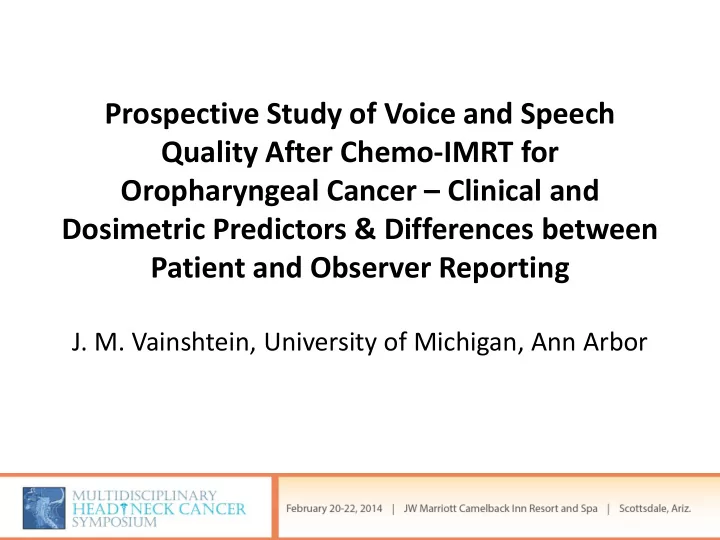

Prospective Study of Voice and Speech Quality After Chemo-IMRT for Oropharyngeal Cancer – Clinical and Dosimetric Predictors & Differences between Patient and Observer Reporting J. M. Vainshtein, University of Michigan, Ann Arbor
Background • The effects of chemoradiation on swallowing difficulty and mouth dryness in patients treated for head and neck cancer have been extensively described in recent years. • The impact of chemoradiation on voice and speech quality remains poorly characterized. • The present study assessed voice and speech quality outcomes, as reported by both patients and physician observers, after intensity modulated radiation therapy with concurrent chemotherapy (chemo-IMRT) for oropharyngeal cancer (OPC).
Study Population • 93 patients with locally advanced Stage III/IV OPC treated at University of Michigan on two consecutive prospective clinical trials of organ-sparing chemo-IMRT. o IMRT intended to minimize radiation dose to the swallowing and salivary structures o Weekly carboplatin & paclitaxel chemotherapy • All patients completed HNQOL- and UWQOL-validated questionnaires at pre-treatment and 1, 3, 6, 12, 18 and 24 months after treatment. • Observer-rated toxicity scored by physicians using CTCAE version 3.0. • Prevalence and factors associated with patient-reported voice quality worsening from baseline and speech impairment were assessed.
Patient Reported Voice & Speech Quality after Chemo-IMRT HNQOL Communication Speech Impairment by UWQOL Domain Score Questionnaire Time to return to baseline Time to return to baseline
Voice and Speech Worsening After Chemoradiation – Differences in Reporting by Patients and Observers % Reporting Worsening from Baseline 1 mo 3 mo 6 mo 12 mo 18 mo 24 mo HNQOL Communication 68% 56% 46% 33% 31% 24% Domain UWQOL Speech Domain 41% 26% 29% 28% 15% 22% Observer-Rated Toxicity - 7% 5% 0% 0% 0% (CTCAE)
Radiation Dose to Glottic Larynx vs. Probability of Patient-Reported Voice Quality Worsening from Pre-treatment % with Voice Quality Worsening Larynx Dose 6 mo 12 mo <20 Gy 25% 10% >20-30 Gy 33% 32% >30-40 Gy 59% 25% >40-50 Gy 50% 30% >50 Gy 64% 63% • Similar findings for patient-reported speech impairment • Results independent of other patient & treatment factors
Conclusions • Post-therapy voice and speech changes were frequently reported by patients, under-recognized by clinicians and independently associated with dose to the glottic larynx. • Reducing radiation dose to the glottic larynx when the larynx is not a target is likely to translate into improved voice and speech outcomes after chemo-IMRT. • Our findings highlight the critical role of patient-reported outcomes in identifying areas of improvement of our current therapies, which may ultimately translate into improvements in quality of life for our patients.
Recommend
More recommend